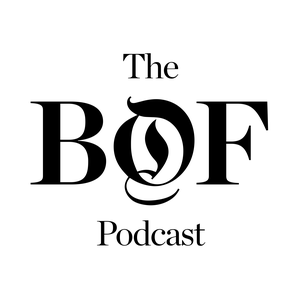The Business of Fashion Podcast Zusammenfassung
Erhalte die neuesten Folgen und Zusammenfassungen von The Business of Fashion Podcast direkt bei uns.

Der The Business of Fashion Podcast Podcast
Der Podcast "The Business of Fashion Podcast" ist eine unverzichtbare Quelle für alle, die in der Modebranche tätig sind oder sich für die dynamische Welt der Mode interessieren. Mit einer weltweiten Anhängerschaft in über 200 Ländern bietet dieser Podcast tiefgehende Einblicke und spannende Diskussionen für Modemacher, Führungskräfte und Unternehmer. Jede Episode beleuchtet die neuesten Trends, analysiert wichtige Entwicklungen und bietet exklusive Interviews mit führenden Köpfen der Branche.
Die Zuhörer können sich auf inspirierende Gespräche freuen, die sowohl die kreativen als auch die geschäftlichen Aspekte der Modewelt abdecken. Von den Herausforderungen der Nachhaltigkeit über die Auswirkungen der Digitalisierung bis hin zu den Geheimnissen erfolgreicher Markenstrategien - "The Business of Fashion Podcast" bietet ein umfassendes Spektrum an Themen, die sowohl für Brancheninsider als auch für neugierige Neueinsteiger von Interesse sind.
Dieser Podcast ist ein Muss für alle, die die Modebranche nicht nur verstehen, sondern auch aktiv mitgestalten möchten. Egal, ob man nach neuen Inspirationen sucht oder die neuesten Entwicklungen im Modebusiness verfolgen möchte, "The Business of Fashion Podcast" liefert wertvolle Informationen und spannende Geschichten, die die Hörer fesseln und bereichern werden.
Die besten Podcasts, ganz einfach.
Erhalte kurze und aufschlussreiche Zusammenfassungen deiner Lieblingsshows, per E-Mail, jeden Tag.
So funktioniert es

Schritt 1: E-Mail eingeben und verifizieren
Klicke auf den Verifizierungslink, den du von uns per E-Mail erhältst.
Schritt 2: Wähle aus 593 Podcasts
Wähle die Podcasts, für die du Zusammenfassungen erhalten möchtest.
Schritt 3: Erhalte Zusammenfassungen
Erhalte Zusammenfassungen in deinem Posteingang, sobald eine neue Folge erscheint.
Melde dich kostenlos an.
Kostenlos starten!Bereits Mitglied? Konto verwalten.
Letzte Episoden:
-
Luxury’s Italian Sweatshops Problem
Veröffentlicht am: 03.01.2025
Over the past year, the pristine image luxury brands have built on their links to artisanal craft, ethical manufacturing and quality has begun to crumble, buffeted by a scandal that has linked labels including Dior and Armani to sweatshops in Italy. According to investigators in Milan, factories producing for the brands were operating illegally and exploiting workers. Dior and Armani have said the allegations don’t reflect their commitment to ethical practices, but prosecutors say the...
Over the past year, the pristine image luxury brands have built on their links to artisanal craft, ethical manufacturing and quality has begun to crumble, buffeted by a scandal that has linked labels including Dior and Armani to sweatshops in Italy. According to investigators in Milan, factories producing for the brands were operating illegally and exploiting workers. Dior and Armani have said the allegations don’t reflect their commitment to ethical practices, but prosecutors say the issues uncovered by the probe are systemic and entrenched. Around a dozen more brands could still be implicated, with further cases expected in the coming months. This week, BoF senior correspondent Sheena Butler-Young and chief sustainability correspondent Sarah Kent discuss the findings of BoF’s own investigation into how exploitative practices persist in luxury’s supply chains and what the scandal means for the industry. Key Insights: Luxury brands use their high prices and Italian manufacturing to sidestep concerns over labour practices frequently levelled against lower-priced labels. But the problems pervade even Italy’s most exclusive supply chains. “This may seem shocking and surprising to those outside this part of the industry, but in Italian manufacturing, everyone knows,” said Kent. “It's an open secret.”BoF’s investigation found brands routinely turn a blind eye to labour exploitation, ignoring red flags raised by audits and sustainability teams in the interest of convenience and cost. New regulations mean the risks associated with such scandals will soon be much more severe. Under incoming European due-diligence rules, brands could be subject to penalties of up to five percent of global revenue if they fail to adequately monitor and prevent labour abuses in their supply chains. “There are still a lot of questions around how that's going to be enforced and what that might actually mean,” said Kent. “But that is a chunky piece of change for any big company.”Additional Resources:Inside Luxury’s Italian Sweatshops ProblemIs Luxury Finally Set for a Sustainability Reckoning?Are Luxury Brands Still Worth It? Hosted on Acast. See acast.com/privacy for more information.
-
What Happens When It’s Too Hot to Make Fashion?
Veröffentlicht am: 26.12.2024
In recent years, extreme weather events have become commonplace catastrophes. And in an increasingly globalised fashion system, developing nations often bear the brunt of climate crises. For fashion and its complex global supply chains — which disproportionately depend on resources and labour from these countries near the equator — one of the most urgent issues is extreme heat. In April, the Philippines, Thailand, Bangladesh and India all experienced merciless and sometimes deadly t...
In recent years, extreme weather events have become commonplace catastrophes. And in an increasingly globalised fashion system, developing nations often bear the brunt of climate crises. For fashion and its complex global supply chains — which disproportionately depend on resources and labour from these countries near the equator — one of the most urgent issues is extreme heat. In April, the Philippines, Thailand, Bangladesh and India all experienced merciless and sometimes deadly temperatures, which shuttered workplaces and schools. According to the US National Centers for Environmental Information, Africa, Asia, and Europe all logged their warmest Julys since global records began in 1850. To discuss what this means for fashion, BoF’s chief sustainability correspondent Sarah Kent convened a panel of global experts:Laurie Parsons of Royal Holloway at the University of London, who focuses on the garment industry and climate vulnerability, explains: “What's at stake is the productivity of the industry, the health of the workers and as more and more of these stories come out, the reputation of an industry.” From Brazil, Beto Bina, the founder and CEO of supply chain consultancy FarFarm says: “Thinking as an ecosystem, you can be philanthropic, you can bring in public policies. It’s a job for innovation, for marketing, for sustainability. If you bring these teams together and develop an innovative project to start this new supply chain that could be amazing for everyone.”From Sri Lanka, Abiramy Sivalogananthan, country coordinator at Asia Floor Wage Alliance, who adds: “The freedom of association should be ensured. Workers should be able to talk to be part of the union, to fight for their rights with the factory’s management.” Key Insights: Workers in garment factories face a range of challenges that often go unaddressed, particularly in the Global South. Sivalogananthan highlights the critical need for collective bargaining to give workers a voice in addressing these issues. “They should be able to talk to whom they need to talk. They need to talk with the unions who should be part of it. And then as a collective, they should be able to talk to the supplier and of course able to talk to the fashion brands.” While many fashion brands are proud of their sustainability initiatives, these efforts overwhelmingly focus on reducing emissions, neglecting the immediate impacts of climate change on workers. Parsons points out this glaring gap, stating, “almost every brand focuses on decarbonisation, but there is an infinitesimally small amount of sustainability policies that actually focus on the populations affected by climate change.”Bina further emphasises the interconnectedness of fashion brands and the broader environmental and social systems they rely on. “If you buy cotton, you are part of the agriculture industry,” she says. “We need to start to recognise this is part of the business and the brand.” Instead of viewing climate impacts as externalities, brands must integrate systemic accountability into their operations to ensure long-term viability and ethical production, she added. Additional Resources:Why Hotter Weather Matters for Fashion What Happens When It’s Too Hot to Make Fashion? | BoF Hosted on Acast. See acast.com/privacy for more information.
-
Alessandro Michele and Jacopo Venturini on the New Valentino
Veröffentlicht am: 20.12.2024
Over the summer, BoF editor-in-chief Imran Amed and editor-at-large Tim Blanks both spent time with Valentino’s new creative director Alessandro Michele to learn about his vision for the fabled Roman couture house.One thing became clear in those conversations. Alessandro was drawn to Valentino in part because it would reunite him with Valentino’s CEO, Jacopo Venturini. Alessandro and Jacopo first made magic at Gucci, alongside CEO Marco Bizzari, when the luxury megabrand quadrupled ...
Over the summer, BoF editor-in-chief Imran Amed and editor-at-large Tim Blanks both spent time with Valentino’s new creative director Alessandro Michele to learn about his vision for the fabled Roman couture house.One thing became clear in those conversations. Alessandro was drawn to Valentino in part because it would reunite him with Valentino’s CEO, Jacopo Venturini. Alessandro and Jacopo first made magic at Gucci, alongside CEO Marco Bizzari, when the luxury megabrand quadrupled its profits after a period of slow growth in the post-Tom Ford era. There is a special symbiosis in their pursuit of creativity and business, based on a strong emotional connection and a shared passion for creating beautiful things together.In their first-ever joint talk, Alessandro and Jacopo joined Tim Blanks at BoF VOICES 2024 to share their plans for Valentino and go inside their unique creative process.Key Insights: Michele describes his approach to Valentino as a blend of honouring its heritage while infusing it with his own perspective. "I try to be gentle … It’s not my place, it’s me working in that place,” he explains. “There is always a conversation [with Valentino].” Michele acknowledges that his work divides opinions, especially online. “Some people feel aggressive in front of the freedom of someone else … I’m happy with myself because I am free.” Finishing the thought, Venturini says Michele’s work embodies “genius creativity that starts with real freedom … He has eyes that open the eyes of someone else.” Venturini further highlights how creativity fuels not just design but the entire business ecosystem. “Our company is really human-centric and creativity-centric,” he says. “The goal is to translate this energy into the real world without losing any of it."Michele embraces the inherent unpredictability of the fashion industry, stating, "I’m understanding that you cannot really plan in fashion." He likens his role at Valentino to cultivating a "beautiful garden" where experimentation and creative freedom allow for growth and innovation. Additional Resources:Alessandro Michele’s Valentino Vision | BoF The BoF Podcast | Alessandro Michele: ‘There Is Always Mr. Valentino Somewhere With Me.’Alessandro Michele’s Valentino Debut: Lightness, Luxury and ‘Fireflies Seeking Love’ | BoF Hosted on Acast. See acast.com/privacy for more information.
